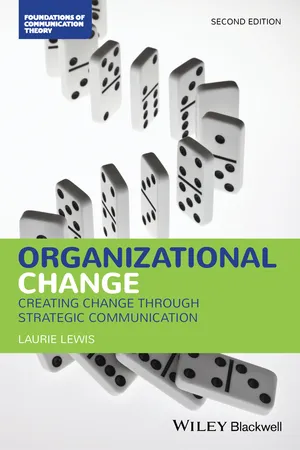
- English
- ePUB (mobile friendly)
- Available on iOS & Android
About this book
A comprehensive guide to essential theories and practices of change creation and implementation
Organizational Change provides an essential overview to implementing deliberate and focused change through effective communication strategies. Author Laurie Lewis integrates academic rigor with real-world case studies to provide a comprehensive examination of both theoretical and pragmatic approaches to alterations and modifications of organizational structures. Emphasizing the importance of formal and informal communication in implementation of change, this text investigates methods of information dissemination and examines various channels for communicating change. Coverage of stakeholder relationships, concepts of uncertainty and resistance, assessing change outcomes, and more provides readers with a solid foundational knowledge of change dynamics in organizations.
Extensively revised and updated, this second edition provides new case studies on topics such as design of input solicitation, and current research in areas including the persuasive effects of sidedness or inoculation, and socially supportive communication. Improved pedagogical tools, streamlined organization of topics, and additional charts, graphs, and images reinforce efficient presentation of material and increase reader retention and comprehension.
- Examines empirical, theoretical, and conceptual approaches to strategic communication during organization change
- Explores key elements of change, appropriate communication strategies, and outcome evaluation methods
- Presents adaptive and programmatic strategic implementation models
- Provides studies of real-world companies and actual research on organizational change
- Debunks popular myths and clarifies misunderstandings of research and theory on implementation of change
- Demonstrates how Individuals, groups, and entire organizations can create change and influence implementation.
Organizational Change provides a thorough survey of the communication and implementation strategies, methods, and conceptual foundations of change in public and private sector organizations, suitable for undergraduate and graduate study and practitioners with interest in complex change implementation.
Frequently asked questions
- Essential is ideal for learners and professionals who enjoy exploring a wide range of subjects. Access the Essential Library with 800,000+ trusted titles and best-sellers across business, personal growth, and the humanities. Includes unlimited reading time and Standard Read Aloud voice.
- Complete: Perfect for advanced learners and researchers needing full, unrestricted access. Unlock 1.4M+ books across hundreds of subjects, including academic and specialized titles. The Complete Plan also includes advanced features like Premium Read Aloud and Research Assistant.
Please note we cannot support devices running on iOS 13 and Android 7 or earlier. Learn more about using the app.
Information
1
Defining Organizational Change
To improve is to change; to be perfect is to change oftenWinston Churchill
Life is change. Growth is optional. Choose wiselyUnknown
Wisdom lies neither in fixity nor in change, but in the dialectic between the twoOctavio Paz, Mexican poet and essayist
…the airline was treated as an extension of the public administration or government departments under the control of politicians who allot key management posts as political favors. None of the executives had sufficient time to develop and implement any strategy to address the negative profitability and to ensure the long‐term survival of the airline (p. 650)
The Role of Communication in Triggering Change
- The need for organizations to stay in line with legal requirements (e.g. employment law, health and safety regulations, product regulation, environmental protection policies)
- Changing customer and/or client needs (e.g. changing demographics, fashions that spur desire for specific products and services)
- Heightened problems or needs of clients served
- Newly created and/or outdated technologies
- Changes in availability of financial resources (e.g. changes in investment capital)
- Funding agencies for nonprofits
- Administrative priorities for government agencies
- Alterations of available labor pool (e.g. aging workforce, technological capabilities of workforce, immigration)
- Trends in alternative labor arrangements
- Alteration of trade relationships or global economy
- Crisis in the industry, economy, government, or organization.
Failure in Change
Table of contents
- Cover
- Table of Contents
- Introduction
- 1 Defining Organizational Change
- 2 Processes of Communication During Change
- 3 A Stakeholder Communication Model of Change
- 4 Outcomes of Change Processes
- 5 Communication Approaches and Strategies
- 6 Power and Resistance
- 7 Antecedents to Strategies, Assessments, and Interactions
- 8 Stakeholder Interactions
- 9 Applying the Model in Practice
- Glossary
- Index
- End User License Agreement